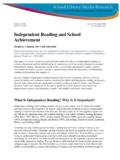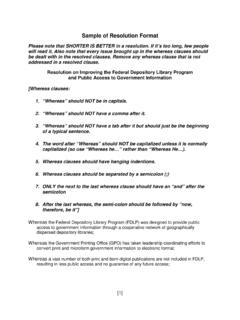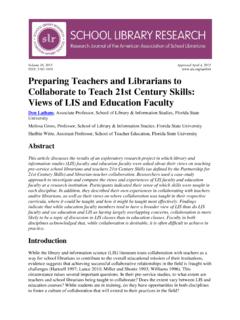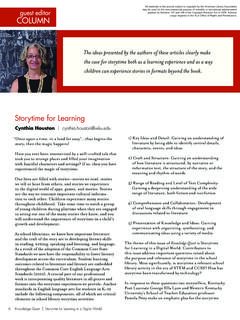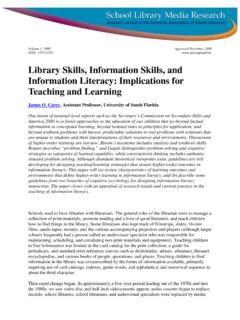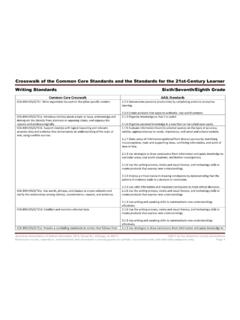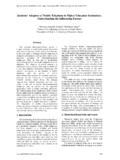Transcription of Standards for Libraries in Higher Education
1 Standards for Librariesin Higher EducationThe Standards for Libraries in Higher Education are available for download at: copies may be purchased from the Association of College and Research Libraries . Email for more for Libraries in Higher EducationApproved by the ACRL Board of DirectorsFebruary 12, 2018 The Association of College and Research LibrariesA division of the American Library AssociationChicago, Illinois Association of College & Research Libraries , a division of the American Library Association, 2018 Standards for Libraries in Higher Education 5 INDEX5 Introduction10 Principles and Performance Indicators15 Appendices15 Appendix 1: Sample Outcomes21 Appendix 2: Benchmarking and Peer Comparison26 Appendix 3: Sources Consulted28 Appendix 4: History of the Standards30 Appendix 5.
2 Members of the 2018 ACRL Standards for Libraries in Higher Education Task ForceINTRODUCTIONThe Standards for Libraries in Higher Education are designed to guide academic Libraries in advancing and sustaining their role as partners in educating students, achieving their institutions missions, and positioning Libraries as leaders in assessment and continuous improvement on their campuses. Libraries must demonstrate their value and document their contributions to overall institutional effectiveness and be prepared to address changes in Higher Education , including accreditation and other accountability measures. These Standards were developed through study and consideration of issues and trends in Libraries , Higher Education , and accrediting practices. The committee solicited input from librarians and library stakeholders at various types of institutions as well as drawing on research and best practices in the Standards articulate expectations for library contributions to institutional effectiveness.
3 The Standards are structured to provide a comprehensive framework using an outcomes-based approach, with evidence collected in ways most appropriate for each are encouraged to use these Standards as they best apply to their local mission and vision. The committee endeavored to be as inclusive as possible, recognizing that each library is different and will adapt the Standards accordingly. For example, some Libraries choose to look at the Standards in a cycle of assessment such as the cycle used to assess student learning, for example, identify one or two principles to assess per year. Others may use the Standards as part of their program review, providing structure to present evidence in a formal ConsultedThe principles in this document reflect the core roles and contributions of Libraries and were distilled from relevant Higher Education , accreditation, and professional documents.
4 Professional sources consulted include the ACRL Strategic Plan 2020, the ALA Library Bill of Rights and Code of Ethics, the Association of Research Libraries Mission Statement and Guiding Principles, ACRL s Value of Academic Libraries report, and previous ACRL Standards for Libraries in Higher EducationIssues and trends in Higher Education have direct impact on the missions and outcomes of academic Libraries and their institutions and require careful attention. Current concerns in Higher Education include increasing demands for accountability within the academy, expectation for outcomes-based assessment of learning and programs, efforts to increase retention and graduation rates, greater emphasis on student success, the acknowledged connection between student engagement and academic achievement, and the importance of pedagogical practices such as research and inquiry-based learning.
5 Documents and publications from the Association of American Colleges & Universities, the Association of Public and Land-grant Universities, and the American Association of State Colleges and Universities were consulted in the development of the updating the Standards , the committee consulted accrediting bodies, ACRL consultants who use the Standards for external review, the ACRL Standards Training Team, and the current ACRL Board of Directors, among others. During this period of discovery, trends emerged in the area of personnel, including reliance on student employees and the continuous evolution of librarian roles. A goal of the committee was to gain an understanding of how the Standards were being used in practice. As a result, the committee broadened the scope of some performance indicators dealing with technology and leadership to encourage applicability to more Libraries . For ease of use, substantive changes were made to the appendices to provide a variety of contemporary examples for Libraries to use as a starting the spring of 2010, the committee surveyed academic library directors who stressed the importance of relating library Standards to accreditation Members of accreditation review teams were also consulted to identify library characteristics within the context of institutional accreditation.
6 Combining these results with concepts and specific language from regional accrediting agencies, the committee created a set of Standards that provide Libraries with a structure that fits in seamlessly with institution accreditation reports. Using the Standards helps Libraries follow accreditation trends such as employing assessment results for continuous improvement, focusing on student success outcomes, benchmarking, and aligning library and institutional missions. During the 2017 revision process, members of accreditation review teams were also consulted to identify potential library contributions and expectations within the context of institutional StructureThe core of the Standards is the section titled Principles and Performance Indicators. The nine principles and their related performance indicators are intended to be expectations Standards that apply to all types of academic Libraries .
7 Nonetheless, each library must respond to its unique user population and institutional for Libraries in Higher Education 7 Libraries are encouraged to use the following outcomes-based method to adopt the Standards :1. align with the principles;2. identify and select performance indicators that are congruent with their institution s mission and contribute to institutional effectiveness;3. add performance indicators that apply to the specific library (for example, open access initiatives for research Libraries , or workforce development support for community colleges);4. develop user-centered, measurable outcomes that articulate specifically what the user is able to do as an outcome of the performance indicator;5. conduct assessments that may be quantitative, qualitative, or both;6. collect data from assessments that demonstrate degree of success; and7.
8 Use assessment data for continuous improvement of library some cases, gathering evidence will not require assessment. For example, the library might provide evidence that library staff have Education and experience sufficient for their positions by compiling a list of staff members with titles, Education , and relevant experience all cases, however, principles lead to performance, which requires evidence to measure success, impact, or two forms of the model are portrayed graphically model:Outcomes-based assessment model:The Standards document provides examples of outcomes (Appendix 1) and metrics (Appendix 2). These are intended as possibilities only, rather than as checklists of requirements to be the performance indicators in the Standards , many of the sample outcomes could apply to any academic library. The sample outcomes and metrics are provided along with the Standards to demonstrate a pattern and provide possible tools with which to construct measurable outcomes based on local IndicatorsOutcomesAssessmentImpactPrinci plesEvidenceEvidencePerformance Indicators8 Standards for Libraries in Higher EducationACRL defines outcomes as the ways in which library users are changed as a result of their contact with the library s resources and programs.
9 2 Thus, outcomes are user-centered, whereas performance indicators are library-centered. Since outcomes are user-centered, it is recognized that they are not wholly under library control. Nonetheless, the outcome or impact of the library s actions is ultimately how the library must judge its success. Local outcomes and metrics should be tailored to the institutional mission, goals, and assessment can be assessed by gathering and analyzing qualitative data, quantitative data, or both. For example, to assess whether students consider access to collections sufficient to support their educational needs, one might survey students and obtain quantitative data. The results might be a metric such as the percentage of students who are satisfied or very satisfied with collections support for their educational needs. Focus groups or interviews might be used to solicit qualitative feedback, such as comments.
10 Assessment may involve using metrics to benchmark performance against that of peer institutions or track library performance over a period of time. For example, a ratio of volumes to combined total student FTE or head counts is a metric that could be compared with peers and considered when determining whether collections are sufficient to support students educational needs. Choice of metrics, like choice of outcomes, will depend on the institution, the accreditation process, and the library-specific context. The power of metrics is in their interpretation and presentation. Outcomes, assessment, and evidence all are elements of the continuous improvement of the StandardsThese Standards were approved by the ACRL Standards Committee and the ACRL Board of Directors. They supersede the 2011 Standards for Libraries in Higher Education and all other previous versions of Standards created by ACRL subsections.
